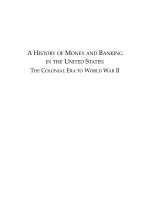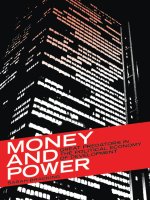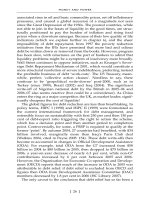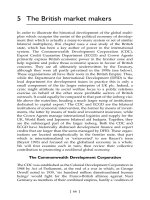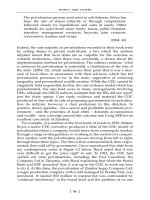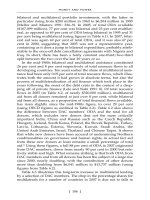the cash nexus; money and power in the modern world, 1700 to 2000 (2001) ferguson
Bạn đang xem bản rút gọn của tài liệu. Xem và tải ngay bản đầy đủ của tài liệu tại đây (11.57 MB, 576 trang )
BESTSELLING AUTHOR
OF THE
PITY
OF WAR
NI AL
ERGUSON
ONEY
AND
POWER
IN THE
MODERN
WORLD,
1700-2000
ASH
xus
$30.00 US
$44.95 CAN
idea that money makes the world go
round is a seductive one. From class conflict to the
"feel good" factor, from Karl Marx to Bill Clinton,
few of us would deny the importance of the econo-
my in politics. Economic change has seemed to he
the prime mover of political change whether in the
age of industry or the Internet. The Clinton cam-
paign motto in 1992—"It's the economy, stupid"—
sums up a central assumption of modern life.
In The Cash Nexus, Oxford historian Niall
Ferguson challenges this assumption by offering a
radical new history of the relationship between
economics and politics. Setting contemporary
issues in a three hundred year historical perspec-
tive, he brilliantly redefines the "cash nexus"—
the pivotal link from money to power.
Throughout modern history, Ferguson argues,
the way states have managed their money has
been crucial to their survival and success. It has
been finance as much as firepower that has decid-
ed the fates of nations in the supreme test of war.
And war itself has been the principal engine of
financial innovation. Our lives today are still dom-
inated by the institutions of the warfare state:
income tax, parliaments, national debts, central
banks and even stock markets. This is the "square
of power" on which the great Western empires
have been based.
Yet the evolution of these institutions over
three centuries has been anything but a one-way
street. There is no universally optimal equilibrium
in the balance between taxing and borrowing, and
sometimes a high debt burden can be a source of
strength rather than weakness. The democratiza-
tion of parliamentary institutions in the twentieth
century has not always been conducive to econom-
ic stability and a bigger tax base. Sometimes the
square of power can collapse into tax revolts,
defaults, inflations or financial panics.
Ferguson arrives at provocative conclusions.
Domestic political power may have more to do
with campaign finance than with pre-election
(continued on back flap)
(continued from front flap)
prosperity; but we should spend more, not less, on
the democratic process. Financial globalization in
the absence of imperial rule may prove too unsta-
ble to last; compared with past superpowers, the
United States is neglecting its international
responsibilities. Stock market bubbles and
exchange rate crises may just be harbingers of a
deeper crisis that could roll back the advance of
democracy and capitalism.
A bold synthesis of political history and mod-
ern economic theory, The Cash Nexus has chal-
lenging and unsettling implications for the future
of both capitalism and democracy. Its challenge
to the United States to make more political use of
its unmatched economic resources is bound to
spark heated debate.
NIALL FERGUSON is Professor of Political
and Financial History at the University of Oxford
and Visiting Professor of Economics at the Stern
School of Business, New York University. He is
the author of Paper and Iron, The House of
Rothschilds, and Basic's own The Pity of War and
Virtual History. He writes regularly for the Times
Literary Supplement and is a prolific commentator
on contemporary politics. He is currently at work
on a major new history of the Saxe-Coburg House
of royalty.
Jacket design: Tom Stvan; author photograph: Marc Atkins
2/01
Praise
for THE
CASH NEXUS
A fascinai in», innovative
and
highly creative analysis
oft
lie interaction
of polities,
war and
national economies. Wide ranging
in
time
and
scope—more than
one
thousand years
and
almost
the
entire settled
world—it
will
be a
'must read*
for
anyone interested
in
long-nul evolu-
tion
and
development."
—LANCE DAVIS, California Institute
of
Technology
"Erudite
and
completely persuasive. Ferguson continues
to
demonstrate
how
to
write authoritative
and
appealing history.
In
lhis hook
he
offers
a
hold
and
convincing explanation
of how the
modern world
has
been
shaped over
the
last three centuries. Economic forces
are
important
hut
Ferguson shifts
the
emphasis, weaving powerful political, social
and
other elements into
the
account.
A
brilliant hook."
-^FORREST CAPIE, City University, London
"This
controversial hook
is a fascinating interweaving of
history, politics
and economics.
The
central thesis
is
that major political events such
as
wars explain
the
evolution
of
our fundamental economic
as
well
as
political
institutions. Ferguson's historical
and
political perspective provides impor-
tant
insights
into
our
understanding of
the
economic
development of
the
modern world."
—MICHAEL
I).
BORDO, Rutgçrs University
"The Ûash Xenix
is a
masterful synthesis
of
modern world economic,
political
and
financial history. Ferguson essays with great insight
the
interrelationships
of
money, hond
and
slock markets, taxes, national
power,
and the
causes
and
effects
of
wars.
All of us,
especially American
leaders, should absorb
its
lessons
if the new
century
is to he
more peace-
ful
than
the one We
have just left
behind."
—RICHARD SÏLLA,
The
Stern School
of
Business, New York
university
A Member
of the
Perseus Books Group
www.basicbooks.com
.—-
/
/I 11/1 -z
US $30.00
/
$44.95 CAN
ISBN D-Hb5-[]2325-fi
5
3 0 0 0
The Cash Nexus
ALSO BY NIALL FERGUSON
The Pity of War
Virtual History: Alternatives and Counterfactuals
(editor)
The House of Rothschild
Paper
and Iron: Hamburg Business and German Politics in the Era
of Inflation, iH^j-i^zj
NIALL
FERGUSON
The Cash Nexus
MONEY
AND POWER IN THE
MODERN WORLD, I7OO-20OO
BASIC
B
BOOKS
BASIC
BOOKS
Copyright
© 2001 by Niall Ferguson
Published by Basic Books
A
Member of the Perseus Books Group
All
rights reserved. Printed in the United States of
America.
No part of
this
book may be reproduced
in any manner whatsoever without written permission except in the case of brief quotations embodied
in critical articles and reviews. For information, address Basic Books, 10
East
53
rd
Street, New
York,
NY
10022-5299.
A
Cataloging-in-Publication record for
this
book is available from the
Library
of Congress.
ISBN
0-465-02325-8
01
02 03 /
10
9 8 7 6 5 4 3 2 1
For
Mary
and
May
man and man . . . Cash Payment the sole
nexus;
and
there
are so many
things which cas
will
not
pay!
Cash is a great
miracle;
yet it has not all
power
in
Heaven,
nor even on Earth. . . .
THOMAS
CARLYLE,
Chartism
(1840)
The
Gospel
of
Mammonism
. . . has also its corresponding
heaven.
For
there
is
one
Reality
among
so
many Phantasms; about one thing
we
are
entirely in earnest: The making of
money.
. . .
We
have profoundly for-
gotten
everywhere
that
Cash-payment
is
not the sole relation of human
beings.
THOMAS
CARLYLE,
Past
and
Present
(1843)
The
bourgeoisie
has left remaining no other
nexus
between man and
man
than
naked self-interest,
than
callous
'cash payment'.
MARX
AND
ENGELS, The
Communist
Manifesto
(1848)
We are
told
by
men of
science
that
all
the venture of
mariners
on the sea,
all
that
counter-marching tribes and
races
that
confounds
all
history
wiht
its dust and rumour, sprang from nothing more abstruse
than
the laws
of
supply
and demand, and a certain natural instinct for cheap rations.
To any one
thinking
deeply,
this
will
seem
a dull and pitiful explanation.
ROBERT
LOUIS
STEVENSON,
"Will
o'
the
Mill"
(1978)
List
of Tables xi
List
of
Figures
xiii
List
of
Illustrations
xvi
Acknowledgments
xvii
List
of
Abbreviations
xix
Introduction
i
SECTION ONE:
SPENDING AND TAXING
1.
The Rise and Fall of the
Warfare
State
23
2.
"Hateful
Taxes" 51
3. The Commons and the Castle:
Representation and Administration 77
SECTION TWO:
PROMISES TO PAY
4.
Mountains
of the
Moon:
Public
Debts
105
5. The Money Printers: Default and
Debasement 137
6. Of
Interest
163
SECTION THREE:
ECONOMIC POLITICS
7. Dead Weights and Tax-eaters: The
Social History of Finance 189
8. The Silverbridge System: Electoral
Economics 217
SECTION FOUR:
GLOBAL
POWER
9. Masters and Plankton: Financial
Globalization 261
10. Bubbles and Busts: Stock Markets
in the Long Run 296
IX
CONTENTS
11. Golden Fetter, Paper Chains:
International Monetary Regimes 321
12. The American Wave: Democracy's
Flow and Ebb 346
13.
Fractured Unities 373
14. Understretch: The Limits of
Economic Power 390
Conclusion
419
Appendices
427
Notes 435
Bibliography
491
Index
533
x
List
of
Tables
1. Defense expenditure as a percentage of total public spending,
1891–1997 44
2. Average annual central government budget deficits as a
percentage of national product, selected periods 122
3. The growth and structure of the London Stock Exchange,
1853–1990 131
4. European price inflation during and after the First
World War 149
5. Increase or decrease in the British national debt by
sub-periods, 1822–1997 169
6. The structure of European national debts, circa
1993
171
7. Determinants of fluctuations in the price of consols,
1845–1900, as cited in The Economist 184
8. The bondholders and the British national debt,
1804–1870
198
9. Redistribution of income through taxes and benefits,
United Kingdom 1992, by quintile groups of households
(£ per year) 204
10.
Dependency ratios, actual and projected,
1900–2050
211
11. Individual membership of the three major British political
parties, 1953–1997 244
12. Foreign holdings of developed countries' national debts,
circa 1993 264
13.
Wars, revolutions and the bond market,
1830–1914
276
14. Anticipated and real premiums on selected international
bonds, 1850–1983 284
15.
Indicators of commercial and financial globalization 291
16.
A tale of two hegemons,
1870–1995
294
17.
Exchange rate regimes and inflation 330
18. Free, partly free and not free countries: the Freedom House
Surveys for 1972–1973 and 1998–1999 355
19. Average democracy score per country, by regions,
1800–1998 360
XI
LIST
OF
TABLES
20. Average democracy score (maximum i.oo, minimum o.oo)
for 136 countries, 1975–1994 372
21.
The
Jews
in economic élites: selected statistics 381
22. World population and the number of independent states
since 1871 383
23.
Military expenditure of the world's principal powers
(in US$ millions, at constant 1995 prices and
exchange rates ) 413
Appendices
A.
The biggest wars in history 428
B. Multiple regression of Bristish government popularity and
economic indicators 429
C.
The global bond market, June 1999 431
D.
Public debt burdens in
1887–1888
432
E. Economic and social indicators and the inter-war crisis of
democracy, 1919–1938 434
Xll
List
of Figures
1.
The "square of
power"
15
2. Military personnel as a percentage of population, 1816–1997
(log. scale) 31
3. Defense spending per serviceman in Britain and the United
States, 1816–1998 (log. scale) 34
4. Defense spending as a percentage of national product,
1850–1998 (log. scale) 46
5.
Income tax as a percentage of taxation,
1866–1999
72
6. Electorate as a proportion of population aged above 20,
1815–1974 87
7.
Government employment as a percentage of total employment,
1960–1999
93
8.
Debt/GNP
ratios since the late seventeenth century 126
9. Debt service as a percentage of government expenditure,
1802–1999 136
10. British money supply and inflation (annual growth rates),
1871–1997 152
11. The real growth rate minus the real interest rate in Britain,
1831–1997 168
12.
British and French bond
yields,
1753–1815
173
13.
Major
bond
yields
since
1700
(annual
averages)
176
14.
The
yield
on consols (end-of-month
figures),
1754–1998
178
15.
Monthly bond
yields,
1914–1945
180
16.
U.S.
long-term bond
yields,
1979–1989
182
17.
Real
returns
on British and American bonds since
1700
197
18. Relative poverty rates before and after taxation and transfers,
1991 206
19. Two alternative ways of achieving generational balance
(percentage increases required) 210
20.
President Clinton's approval rating and the Dow
Jones
index,
1993–2000
221
xiii
LIST
OF
FIGURES
21. Government lead (left-hand axis) and the "misery index"
(right-hand axis), 1948–2000 225
22. The real cost of British elections: candidates' declared general
election expenses, 1880–1997 241
23. Total general election expenditure of the three main British
parties, 1964–1997 (thousands of 1997 pounds) 242
24. Conservative and Labour parties, central expenditure (routine
and election), 1900–1992 (thousands of 1997 pounds) 243
25. Individual Labour Party membership as a percentage of the
UK population, 1928–1977 245
26. Unadjusted yields on European bonds, London prices, end
of week,1843–1871 275
27. Government bonds as a percentage of all securities quoted
on the London Stock Exchange, 1853–1990 281
28. Yield
spreads over consols,
1870–1913
285
29. The Dow Jones industrial average daily closing price,
1896–2000 (log. scale) 298
30. Stock market indices since 1800 (log. scale in dollars,
1969=100) 300
31. The UK 'Equity Risk Premium' (ex post returns on stocks
less returns on bonds), 1700–199 5 303
32.
Inflation-adjusted
UK
stock market index,
1700–1998
308
33. British share indices since 1811 (inflation-adjusted for the
20th century) 309
34. American and British stock market bubbles (percentage
increases in inflation-adjusted annual indices) 313
35.
The Mississippi and South Sea bubbles,
1719–1720
315
36.
The Mississippi bubble: money and share prices 316
37.
Exchange
rates
of major currencies per
US
dollar,
1792–1999
(1913=100)
328
38. World gold production, five yearly totals, 1835–1989 (metric
tonnes) 332
39.
'Progress' of the Ecu/Euro 339
40.
The rise of democracy,
1800–1996
360
41. The average democracy 'score' for 29 European countries,
1900–1950 362
42. Real national product indices for European democracies,
1919–1939 (1927=100) 366
XIV
LIST
OF
FIGURES
XV
43- Real national product indices for European 'dictatorships,'
1919–1939 (1927=100) 367
44.
Number of wars in progress per year,
1816–1992
385
45.
Circles of interest 424
List
of
Illustrations
1. James Gillray, Begging No Robbery:—i.e.—Voluntary
Contribution:—or John Bull, escaping a Forced Loan, 1796 24
2.
James Gillray, after "F. L. Esq.," John Bull Ground Down, 1795 52
3. H. Heath, after George Cruikshnak, The Pillar of State, or
John Bull Overloaded, 1827 78
4. Francis Jukes, An Historical, Emblematical, Patriotical and
Political Print representing the English Balloon or National
Debt in the Year 1782 with a
Full
View of the Stock Exchange,
and
its supporters the
Financiers,
Bulls, Bears, Brokers, Lame
Ducks, and others, and a proportionable
Ball
of Gold, the
specific
size of
all
the Money we have to pay it with supposing
that
to be Twenty Millions of Pounds sterling, the gold and
Silver
Trees entwined with Serpents & upheld by Dragons for
the pleasure of Pluto & all his Bosom Friends, 1785 106
5.
James Gillray, Midas, Transmuting all
into
Paper,
1797 138
6. Anon. (English School), The National Parachute, or John Bull
conducted to Plenty and Emancipation, 1802 164
7.
Anon. (English School), The Tree of Taxation, 1838 190
8. Cheffins, King Cash!—The Boss of Every Election, from
"Illustrated Bits," 1885 218
9. Thomas Derrick, Sentiment on the Stock Exchange, from
"Punch," 1938 262
10. George Cruikshank, The "Stystem" that "Works so Well!!"—
or The Boroughmongers' Grinding Machine, 1831 297
11. Olave Gulbransson, Worshipping the Almighty Dollar, from
"Simplicissimus," 1923 322
12. Olave Gulbransson, President Wilson mounted on Morgan's
Gold Mountain, from "Simplicissmus," 1916 347
13. James Gillray, The Plumb-pudding in danger: or State Epicures
taking un Petit Souper, 1805 374
14.
James Gillray, The Giant Factotum amusing
himself,
1797 391
Photographic
acknowledgments, where applicable: Andrew Edmunds: 1,
2;
Bridgeman Art Library: 6; Fotomas Index: 3, 4, 7, 8,
10,
14;
Mary
Evans
Picture
Library: 9,
11,
12.
xvi
Acknowledgments
This book would not have come
into
existence without the generosity of the
Trustees of the Houblon-Norman Fund at the Bank of
England,
whose finan-
cial
support allowed me to spend a year of full-time research at the Bank.
As
an historian venturing
into
economists' territory, I was
especially
grate-
ful
to Mervyn King, Charles Goodhart and John Vickers for their encour-
agement and advice
throughout
my times in Threadneedle Street. I should
also
like to
thank
Bill
Allen,
Spencer
Dale,
Stephen Millard, Katherine Neiss,
Nick
Oulton, Andrew Scott, Paul Tucker and Tony
Yates.
In the Informa-
tion Centre, I was greatly assisted by Howard Picton and Kath
Begley;
and
in the
Archive
Henry Gillett and Sarah Millard were always ready to answer
my questions, no
matter
how obscure. Last, but most certainly not least,
Hilary
Clark, Sandra Dufuss, Chris Jewson and Margot Wilson provided
first-class
secretarial support.
The corollary of my year at the Bank was my absence from Jesus College,
Oxford.
I am particularly grateful to
Dr.
Jan
Palmowski
for so ably taking over
my tutorial and other responsibilities; as well as to my colleague Dr. Felicity
Heal,
whose
life
was not made easier by my absence.
I
would also like to
thank
the Principal and
Fellows
of
Jesus
for granting me special
leave,
not least Peter
Clarke
and Peter Mirfield, who punctiliously dealt with the financial arrange-
ments. The book was
largely
written after I
returned
to
Jesus,
and I should like
to express my gratitude to all the staff at the
College
who in their various ways
made the task easier, especially
Vivien
Bowyer
and Robert Haynes.
Some
parts
of
this
book originated in collaborative work. I am especially
indebted to Glen O'Hara, who provided substantial assistance with Chap-
ter 8. My roommate at the Bank, Laurence Kotlikoff, introduced me to gen-
erational accounting and tried to improve my economics; his influence is
most apparent in Chapters 7 and
11.
I would also like to
thank
Brigitte
Granville
and Richard Batley, with whom I co-wrote academic articles on
related subjects while I was working on the book, and whose influence is dis-
cernible here too. Daniel Fattal was indefatigable in gathering statistics and
quotations from The Economist, while Thomas Fleuriot
hunted
down elu-
sive
references with equal zeal.
Special
thanks
are due to Mike Bordo, Forrest Capie, Charles Goodhart
and Harold James, all of whom generously took time to look at the entire
XVll
ACKNOWLEDGMENTS
manuscript in draft, and saved me from numerous errors. Benjamin Fried-
man and Barry Weingast also read sections of the manuscript and offered
penetrating criticism.
My
first stab at the history of the bond market was given an airing at the
opening conference of the
Yale
School of Management's International Cen-
ter for Finance;
thanks
are due to William Goetzmann and Geert Rouwen-
horst for inviting me to participate, as
well
as to those who offered comments
and suggestions. A
part
of Chapter
11
was presented at N. M. Rothschild &
Sons
during the June 1999 FT Gold Conference; I am grateful to Sir
Evelyn
de Rothschild and Sir Derek Taylor for their invitation to speak. Fareed
Zakaria
encouraged me to put EMU
into
historical perspective for
Foreign
Affairs;
he
will
see how
that
argument developed in the later sections of
Chapter
11.
Some of Chapter
12
originated in a paper given at the confer-
ence on social science and the future held in Oxford in
July
1999;
I should
like
to
thank
Richard Cooper, Graham Ingham and Richard Layard for their
invitation to participate in the conference, and all those present for their
comments, particularly Lord Lipsey. Chapter 13 made an appearance in
draft at a Stanford History Department seminar; I am grateful to Norman
Naimark and his colleagues for their hospitality.
I
would also like to
thank
for miscellaneous comments and information:
Lord
Baker, Sir Samuel Brittan, Phil Cottrell, Eugene Dattel, Lance Davis,
Luca
Einaudi, Walter
Eltis,
Campbell and Molly Ferguson, Marc Flandreau,
John
Flemming, Christian Gleditsch, Michael Hughes, Paul Kennedy, Jan
Tore Klovland, David Landes, Ronald McKinnon, Ranald Michie, Paul
Mills,
Larry Neal, Patrick O'Brien, Avner Offer, Richard Roberts, Hugh
Rockoff,
Emma Rothschild, Lord Saatchi, Norman Stone, Martin Thomas.
François
Velde,
Joachim Voth, Digby Waller, Michael Ward, Eugene White,
David
Womersley, Geoffrey Wood and
J.
F.
Wright.
I
owe a huge debt to Simon Winder and Don Fehr, my editors, who labored
long and hard to improve the original manuscript. Thanks are also due to
Clare
Alexander, my agent, and Elizabeth Stratford, my copy-editor.
Most
of my references are to published articles and books,
rather
than
to
original documents, with a very few exceptions. Leopold I's letter to Queen
Victoria
of
19
September
1840
is quoted with the gracious permission of Her
Majesty
the Queen. I would also like to
thank
Sir
Evelyn
de Rothschild for
permission to quote from documents in the Rothschild Archive.
Finally,
to Susan,
Felix,
Freya and Lachlan I can offer only an apology for
all
the sins of omission and commission perpetrated by the
author
during the
writing of
this
book.
xviii
Abbreviations
ECB
European Central Bank
GDP
Gross
Domestic Product
GNP
Gross
National Product
HMSO
Her Majesty's Stationery Office
IISS
International
Institute
for Strategic Studies
IMF
International
Monetary Fund
INSEE
Institut
National de la Statistique et des Études Économiques
NBER
National Bureau of Economie Research
NIC
National Insurance Contributions
NNP
Net National Product
OECD
Organisation of Economie Cooperation and Development
ONS
Office
of National Statistics
OPEC
Organization of Petroleum Exporting Countries
PSBR
Public
Sector Borrowing Requirement
SIPRI
Stockholm
International
Peace Research
Institute
SPD
Social
Democratic Party of Germany
XIX
The Old Economic Determinism and the New
Money
makes the world go round, of
that
we all are sure—On being
poor.
Cabaret
(1972)
The
idea
that
money makes the world go round—as the Master of Cere-
monies sang in the musical
Cabaret—is
an old one, yet remarkably resilient.
It is
there
in the
Bible,
in
both
the Old and the New Testaments: compare
"Money
answereth all things" (Ecclesiastes
10:19)
with "The
love
of money
is
the root of all
evil"
(1 Timothy, 6:
10).
The sin of avarice was, of course,
condemned by Mosaic law. But in Christian doctrine, as the second apho-
rism suggests, even the normal pecuniary motive was condemned. Part of
the revolutionary appeal of Christ's teaching was the prospect
that
the rich
would
be excluded from the Kingdom of God: it was easier "for a camel to
go
through the eye of needle,
than
for a rich man to enter into the kingdom
of
God" (Matthew
19:
24).
Plainly,
Western Europe would not have progressed so successfully from
feudalism
to capitalism had
this
dogma deterred people from making money.
The
point, of course, was
that
it did nothing of the sort. Rather, it consoled
those (the majority) who had no money and instilled a sense of guilt in those
who
had much: an optimal strategy for an organization seeking
both
mass
membership and substantial private donations from the élite.
The
notion of a fundamental conflict between morality and Mammon also
informed the most successful "secular religion" of modern times. To
Karl
Marx
and Friedrich
Engels,
what was odious about their own
class,
the bour-
geoisie,
was its ethos of "naked
self
interest" and "callous 'cash payment.'"
1
Of
course, Marx's claim
that
the internal contradictions of capitalism would
precipitate its own downfall was supposed to be "scientific" and "objective."
It was the inexorable rise of capitalism and the bourgeoisie
that
had over-
thrown the feudal aristocratic order; in
turn,
the formation in the factories
1
